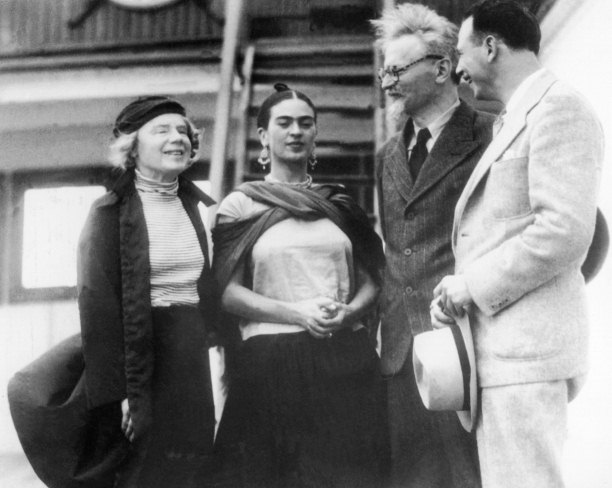Trotsky offered asylum in Mexico
After he was formally condemned to death in Moscow, the Mexican government offered Trotsky refuge and protection, on December 6th 1936.
 After the Russian Revolution of 1917 Leon Trotsky organised the Red Army to fight and defeat the Tsarist Whites. He was the most important figure in the Bolshevik regime after Lenin, but when Lenin’s health began to fail a struggle for the succession developed between Trotsky and Stalin, who was general secretary of the Communist Party from 1922. Intellectually and as an administrator Trotsky was superior to Stalin, but he was no match for the Georgian’s ruthless power hunger.
After the Russian Revolution of 1917 Leon Trotsky organised the Red Army to fight and defeat the Tsarist Whites. He was the most important figure in the Bolshevik regime after Lenin, but when Lenin’s health began to fail a struggle for the succession developed between Trotsky and Stalin, who was general secretary of the Communist Party from 1922. Intellectually and as an administrator Trotsky was superior to Stalin, but he was no match for the Georgian’s ruthless power hunger.
After Lenin died in 1924 Trotsky was gradually removed from all positions of influence. He was kept under surveillance, his phone was tapped and there were mysterious attempts to kill him. In 1926 he was dropped from the Politburo and in 1927 he and his supporters were expelled from the Communist Party. In January 1928 he was exiled to Alma-Ata in Kazakhstan with his wife Natalya Sedova and their son Lev. From there he wrote fierce criticisms of Stalin and blistering attacks on opponents of Stalin and Stalinism in the party who had made their peace with the regime.
In February 1929, accused of counter-revolutionary activity, Trotsky was banished from the Soviet Union and sent to Turkey, with whose regime Stalin had made a deal which included an undertaking that there would be no attempt to assassinate Trotsky on Turkish soil. The Soviet Union gave the family money to help them settle in a comfortable house on an island in the Sea of Marmara and supporters volunteered to help the Turkish police as bodyguards. It was there that Trotsky completed his three-volume History of the Russian Revolution, with Lenin as the hero and Stalin the villain.
In July 1933 a new leftish French government under Edouard Daladier offered the exiles asylum in France, where they settled down at the village of Barbizon near Fontainebleau. Trotsky was writing a biography of Lenin, which he never finished. The French Communist Party attacked the regime for letting Trotsky in, while he pressed his own supporters in Europe to form a new Marxist Fourth International against Stalinism. He was equally opposed to Fascism and urged the German Communists to act against Hitler and the Nazis. The Nazi response was to put pressure on the French government to deport him.
In the spring of 1935 the Norwegian government agreed to let the Trotsky household move near Oslo. It was there that he wrote The Revolution Betrayed, in which he again contrasted the ideals of 1917 with the tyranny Stalin had created. He was now formally condemned to death in Moscow and Soviet pressure prevailed on the Norwegian regime to put him under house arrest in 1936. In December that year the Mexican government offered Trotsky refuge and protection, which he gratefully accepted. He and Natalya sailed from Norway aboard an oil tanker and arrived in Mexico in January 1937.
The Trotskys lived in the Coyoacan area of Mexico City as guests at the Blue House, the home of the painters Diego Rivera and his wife Frida Kahlo. They were both cheerfully promiscuous and Frida took Trotsky to bed, to Natalya’s dismay. Trotsky depended for money on his publications, help from supporters and the fees he charged for interviews and for holding seminars for students. By May 1939 Trotsky and Rivera had had enough of each other and Trotsky and Natalya moved to a house close by on Avenida Viena. The years of exile, danger and uncertainty had weighed Trotsky down. Ill with high blood pressure and thinking about suicide, he looked back over his life. If he had it to live over again, he wrote, he would pursue the same course: ‘I shall die a proletarian revolutionist, a Marxist, a dialectical materialist and, consequently, an irreconcilable atheist.’
In May 1940 an attempt to kill Trotsky by Soviet agents armed with machine guns failed, but on August 20th a charming Spanish Communist and Soviet secret agent calling himself Ramon Mercader, who had managed to infiltrate the household through a love affair with one of Trotsky’s secretaries, took the opportunity to stab Trotsky in the head with a mountaineer’s ice-axe. Trotsky was mortally wounded and died in hospital the next day. He was 60 years old.
Trotsky’s biographer Robert Service has described the killing as ‘the most spectacular assassination since the death of the Archduke Franz Ferdinand in 1914’. Mercader was sent to prison for 20 years. When he was released in 1960 he travelled to Prague and on to Russia, where he was made a Hero of the Soviet Union.




